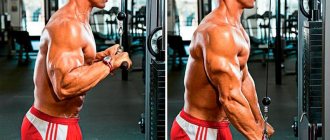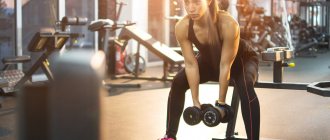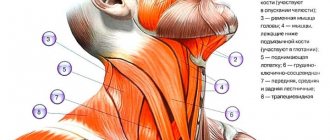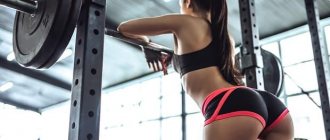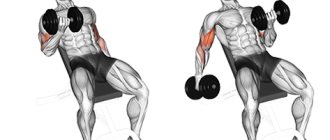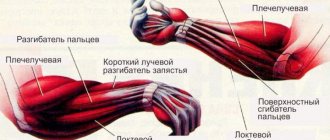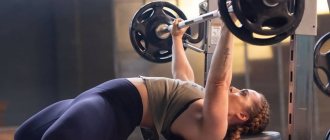If you want to know how to get horseshoe triceps that will blow your mind, then you definitely need to read this article and do these triceps exercises.
When the question arises of how to pump up big arms, triceps, as a rule, are not given due attention. For most people, strong arms are biceps.
But, oddly enough, the biceps take up much less volume of your arms than the larger triceps.
This is why pumping up the triceps is one of the little-known “secrets” to achieving the desired effect of big pumped up arms.
For example, your hands might look like this:
If this is too much for you, then here is a recent photo of mine that illustrates a more realistic result to achieve:
And in this article, I'll tell you how I achieved it (and how you can achieve the same)
So let's start with a quick overview of the triceps muscles and then dive into how to effectively tone them.
Anatomy of the triceps muscles
The triceps, or, in scientific terms, triceps brachii, is the triceps extensor muscle of the posterior shoulder.
From Wikipedia:
Triceps brachii muscle
(
triceps
; lat.
musculus triceps brachii
) - the extensor muscle of the posterior group of the shoulder, occupies the entire back side of the shoulder, consists of three heads - long (caput longum), lateral (caput laterale) and medial (caput mediale).
Functions : Due to the long head, the arm moves backward and brings the arm towards the body. The entire muscle takes part in the extension of the forearm.
Fastening
The lateral head of the triceps (lat. caput laterale) begins with tendon and muscle bundles on the outer surface of the humerus. The medial head of the triceps (lat. caput mediate) has a fleshy beginning on the posterior surface of the middle third of the shoulder. The long head of the triceps (lat. caput longum), begins with a strong tendon from the subarticular tubercle of the scapula. The muscle formed as a result of the connection of the three heads passes into a flat, wide tendon, which is attached to the olecranon process of the ulna.
This is what the triceps brachii muscle looks like:
As you can see, when all three muscles become visible, they will take on a peculiar “horseshoe” shape.
You will also notice that the lateral head (or, as it is also called, the lateral head) is the largest muscle of the three triceps muscles, which both develops faster than the others and determines the overall appearance of your triceps.
In short, when people talk about “big triceps,” what they really mean is big lateral heads.
However, if you want to get a full-fledged volumetric, 3-D look, then you need to properly develop all three heads of the triceps.
Fortunately, this is quite easy to do.
The Importance of Triceps
If trained correctly, the triceps make up the majority of the mass of the upper arm. The triceps must be prepared and worked just as intensively and methodically as the biceps.
A toned triceps actually indirectly helps tone and strengthen the biceps by creating more blood and nutrient flow to the upper arm.
Work your triceps from every angle using a variety of exercises to get impressive arms.
Simple ways to pump up your triceps
There are many theories about how to pump up your triceps muscles.
Some people say to focus on training frequently at an accelerated pace and really feel that burn in your muscles.
Others believe that training several times a week is enough.
There is also an opinion that there is no need to pump up the triceps at all. Instead, focus on pushing exercises such as the bench press and overhead press. Well, I've experienced all of the above, I've also worked with thousands of people, and here's what I've learned:
- Most people need to target their triceps to achieve the size and definition they want.
Intensive training of the chest muscles will help in the formation of triceps, but it is unlikely that this will be enough to achieve the desired size and definition.
- Heavy compound exercises are ideal for building strength and size. High rep sets, cable exercises on a cable machine, and French presses (triceps machine) can be included in your workouts, but they are not a substitute for heavy dumbbell exercises.
- One intensive triceps workout per week is enough. An important part of what you need to do correctly and consistently is volume, that is, the total number of repetitions you do each week.
This is especially important when you work out in the gym (especially when exercising with heavy weights), the main rule of which is:
The heavier your sets, the less you can do per week without the risk of overtraining. This is especially true for really difficult exercises like deadlifts and squats, since the harder your workout, the more time your body needs to recover from it. Now that I've tried many different split workouts and frequency schemes, here's what works best in two extensive reviews.
If your workout involves heavy weight exercises (80-85% +1PR), the optimal volume should be around 60-70 repetitions every 5-7 days.
This applies not only to the triceps, but, as a rule, to any other major muscle group.
In the case of the triceps, we also have to take into account the fact that they are actively involved in your pressing exercises.
If you're doing, say, about 60 reps of the chest press per week to tone your chest and about 15-20 reps of the overhead press for shoulder definition, then an additional 60 reps of weighted triceps training will be unnecessary.
Although, by lowering the reps to 30-40 for the triceps, you will find that this stimulates additional muscle growth without the hassle of overloading.
However, every day I meet people whose triceps are very stubborn even with proper training. In this case, I recommend that they do the following every week:
- 9 sets of intense (4-6 reps) chest presses, plus 3 sets of triceps exercises for 8-10 reps at a time;
- 3 sets of heavy overhead presses after a couple of days;
- 6-9 sets of intense triceps exercises after a few days.
This small increase in weekly volume, of course, will not have an instant magical effect, but it will help overcome the “stubborn plateau” of muscle growth.
And now that we have the basic theoretical aspects of training in stock, let's look at the 5 best exercises for triceps.
How often to pump your triceps? Catching supercompensation
Most instructors recommend Monday-Wednesday-Friday or Tuesday-Thursday-Saturday classes. The frequency of training is a highly individual indicator, so we get the following situation:
- We have 4 athletes who start with the same performance and train according to the same schemes. Everyone follows the training plan from start to finish and follows the trainer’s recommendations;
- The program is suitable for the first athlete. He progresses quickly and in 3 months gains about 10 kilograms of muscle mass and becomes the owner of cool arms. His triceps are better than a lot of guys who work in the gym for a year;
- The program is less suitable for the second athlete. He gains only 3 kg and looks at his comrade with envy;
- The third athlete feels that the load being received is too great for him. After 3 months of training under a SIMILAR program, he loses a kilogram of muscle, becomes covered in acne, and becomes a nervous and apathetic person. These are signs of overtraining;
- The fourth athlete does not feel the load received at all. He thinks the workouts are too easy. In 3 months he gains a kilogram of muscle. He feels that he needs to train more often, but the coach said... These are signs of undertraining.
Instead of giving you a “fish” that can slip out of your hands and swim out to sea, you get a “fishing rod” in the form of an understanding of the phases of the training process:
- Trauma or training . Muscle cells are injured by physical activity. Microtears form, which cause muscle pain. Muscles don't grow during training! They are destroyed! This is very important to realize in order to understand how to pump up your triceps.
- Recovery . The phase that begins immediately after completion of training and lasts until the muscles return to their original state. Recovery can be accelerated with the help of a proper daily routine, nutrition, work on the hormonal system, and the use of sports nutrition. Training during the recovery phase leads to overtraining.
- Supercompensation . The body strives not to experience stress, as a result of which it creates additional reserves - muscles, which will make the repetition of a similar load less stressful for the body. In the supercompensation phase, we follow the principle of load progression. As the objective load increases, subjective sensations remain the same. We do more work, but we don’t feel it.
- Loss of super compensation . Happens:
- In the event that the athlete is lazy and skips training;
- With quick recovery. The athlete trains too infrequently, according to the wrong training plan. There is no progress.
When supercompensation is lost, the body thinks: “There will be no repetition of the load, I stop spending energy on maintaining the created muscles.” The muscles return to their pre-training state. Signs of the recovery phase are muscle pain in the target muscles, lack of desire to exercise, physical and mental heaviness. After a few weeks, you will learn not to confuse this condition with laziness. Beginners do 2 to 4 strength training sessions per week. Target triceps training – 1-2 times a week.
The best exercises for triceps
Don't pay attention to magazines with articles about muscle mass.
You don't need to do 50 types of triceps exercises to get great arms.
In fact, of the many, many triceps exercises you can do, only a small handful will be truly beneficial. Next, I will tell you how to pump up your triceps using the most effective exercises for training the triceps brachii muscle.
For example…
Close grip bench press
If I had to choose just one triceps exercise, it would definitely be the close grip bench press or back push-ups.
Both of these exercises are aimed at strengthening the lateral head of the triceps and, in addition, give impetus to the development of the chest muscles.
Back push-ups
There are two types of push-ups with support from behind: from a gymnastic bench and from parallel bars (vertical)
I prefer dips because they make it easier to do push-ups with extra weight and they help train your shoulders and chest. But both methods are equally good for triceps.
Here's a push-up from a bench:
But from the bars:
Dumbbell Overhead Press
Dumbbell overhead curls are one of my favorite triceps exercises.
It is especially good for the long head of the triceps and allows you to safely lift heavy weights and challenge the muscles.
French bench press with barbell
Tensing the triceps while lying down puts stress on the medial head.
This exercise has been a staple for bodybuilders for decades due to its simplicity and effectiveness.
Extension of arms on the upper block in a standing position
This is the most common triceps exercise that people do, and surprisingly, it's a really good one.
However, I save it for later in my workouts, using it after I've completed the heavier exercises on this list.
I also prefer V-shaped and straight bars.
How to properly pump your triceps? The principle of load progression
The basic principle of pumping up the triceps. It says: the athlete is obliged to regularly increase the objective training stress. Once every 1-3 workouts, it is necessary to increase the weight of the apparatus, the number of approaches, exercises or repetitions while maintaining the correct technique. A training diary will help you follow the principle of progression of loads, as well as planning future workouts. Using the example of the French bench press, the principle of progression of loads for pumping up the triceps will look like this: Workout No. 1
| Exercise | Weight | Approaches | Repetitions | Rest minutes between sets |
| French lying head press | 20 | 3 | 12 | 2 |
Workout #2
| Exercise | Weight | Approaches | Repetitions | Rest minutes between sets |
| French lying head press | 20 | 4 | 12 | 2 |
Workout #3
| Exercise | Weight | Approaches | Repetitions | Rest minutes between sets |
| French lying head press | 20 | 5 | 12 | 2 |
Workout No. 4 . Increasing weight while decreasing the number of approaches
| Exercise | Weight | Approaches | Repetitions | Rest minutes between sets |
| French lying head press | 22,5 | 3 | 12 | 2 |
Workout #5
| Exercise | Weight | Approaches | Repetitions | Rest minutes between sets |
| French lying head press | 22,5 | 4 | 12 | 2 |
Workout #6
| Exercise | Weight | Approaches | Repetitions | Rest minutes between sets |
| French lying head press | 22,5 | 5 | 12 | 2 |
Workout No. 7 . We again reduce the approaches, but increase the weight
| Exercise | Weight | Approaches | Repetitions | Rest minutes between sets |
| French lying head press | 25 | 3 | 12 | 2 |
At workouts 8 and 9 we add one approach each. Workout #10 . Reduce the number of approaches to 3, increase the weight of the barbell
| Exercise | Weight | Approaches | Repetitions | Rest minutes between sets |
| French lying head press | 27,5 | 3 | 12 | 2 |
During training, we add 11-12 per approach. Workout No. 13 . We take away the approaches again, but increase the weight of the barbell
| Exercise | Weight | Approaches | Repetitions | Rest minutes between sets |
| French lying head press | 30 | 3 | 12 | 2 |
Result: over 13 triceps workouts, we increased the weight of the barbell by 50%, which could not but affect the appearance of the arm muscles. In the longer term it will look like this: Workout No. 50
| Exercise | Weight | Approaches | Repetitions | Rest minutes between sets |
| French lying head press | 45 | 5 | 12 | 1,5 |
Workout #100
| Exercise | Weight | Approaches | Repetitions | Rest minutes between sets |
| French lying head press | 62,5 | 5 | 12 | 1,5 |
Workout No. 200
| Exercise | Weight | Approaches | Repetitions | Rest minutes between sets |
| French lying head press | 75 | 5 | 12 | 1,5 |
Over time, the rate of progress slows down. Only beginners (up to 6 months of experience) can increase the load each workout. When we reach significant weight levels, the body is already at its limit, and the rate of progress slows down. But most people don’t need this, since performing a French bench press with a barbell of 50-60 kg guarantees great triceps, provided the correct technique is followed.
Load progression is the key to triceps training.
Before we talk about triceps training, I want to make sure you understand the vital issues of weightlifting in general:
It is important not to just do the exercises, but to do them in progression.
For a true weightlifter, it is important to know that an important type of progression is overload.
This is a gradual increase in how much weight you can lift at one time.
If you do this and eat enough food, your muscles will grow.
Triceps training tips and tricks
Follow these nuances during training, and the result will not be long in coming.
- If your goal is to build bigger triceps, start your workout with basic exercises—presses or push-ups—and perform them for low reps but with good weight. You can finish with one or two isolation exercises, which must be performed all the way (i.e., the maximum number of times).
- Always increase the weight of the equipment carefully, since it is easy to injure the elbow joints, especially in basic exercises.
- To keep the triceps engaged, do not straighten your arms all the way in pressing exercises.
- Concentrate on the negative phases of the movement (triceps stretches), this will make them elastic and reduce the likelihood of injury.
- Do not rest more than two minutes between sets so that the muscles do not have time to completely cool down.
To achieve triceps development, you need to train this muscle 1-2 times a week. It is best not to perform all the exercises in a row at random; you should create a plan of 3-4 exercises, in which at least one will be basic. It is also important to constantly increase the load and perform the exercises efficiently and technically correctly. In this case, you will quickly achieve muscle growth and increase in strength.
Triceps training for mass
I have two criteria by which I define a good triceps workout:
- It includes exercises that target each head of the triceps.
You'll get the most out of triceps exercises that develop the lateral head.
These are exercises that focus on your arms, such as the close-grip bench press, back push-ups, and standing lat pull-downs.
However, you should not neglect exercises that increase the other two heads of the triceps.
Overhead exercises such as dumbbell overhead presses and French bench presses target the long head, while side-arm and underhand exercises and bench presses develop the medial head.
- Emphasizes weightlifting.
There are three ways to stimulate muscle growth, and progressive overload is the most important point in building muscle.
Therefore, your main goal as a weightlifter is to become stronger, especially in difficult key lifts such as the powerlift, squats, and bench and overhead presses.
Training schedule
If the muscle group is large, then it is better to give it a shock load once every 7-8 days. For muscles such as triceps, it is permissible to exercise more often - you can do 2 heavy workouts per week and one light one. Or 1 heavy, 1 light. Training triceps once a week for muscle growth will not be enough.
- When you do any triceps exercise, pay attention to the sensations - you should feel what is working for you. If you do push-ups on the uneven bars, and the next day your pectoral muscle and even your arms hurt, reconsider your technique. Do push-ups so that your triceps get tired. If a muscle becomes stiff, burns, or gets tired after performing an exercise, it means that you are pumping it.
- If your elbows start to hurt, pay attention to your technique, change the bars, and bandage your elbows during the exercises. Try all of this before you quit training. Take a course of joint strengthening supplements that contain chondroitin and glucosamine. Finally, reduce the weights you use and see if the pain goes away.
During isolated arm extensions (French press, cable arm extension), pay attention to the position of your elbows - the further the elbows are from the body, the less load on the triceps. You will feel it.
Press your elbows in - you will immediately understand if this working weight is too big for you. This is the secret of such bench presses. Therefore, always watch your elbows yourself or ask someone to look after you. Following the technique will help you build large triceps without getting injured.
Triceps training program for mass
I’ll give you an example of a simple triceps training program so you can see how well my advice applies to you.
Train as follows once every 5-7 days for the next 8 weeks. Do this, stick to your diet and your triceps will definitely respond to you.
- Close grip bench press
Warm up and 3 sets of 4-6 reps
- Back push-ups
Warm up and 3 sets of 4-6 reps
- French bench press
3 sets of 4-6 reps
That's all.
Just 9 sets for your regular workout.
And in case you don't know how many reps, sets, or how much weight to do, it's very simple:
- If you can do more reps than you expected, your weight is too light. Get heavier.
- If you can't do the minimum in your rep range, the weight is too heavy. Lighten it up.
So, in the case where you can do 6 reps, it's time to add weight. If you are not able to do 4 repetitions, you should reduce the load.
In general, I advise you to add weight when you have completed all reps in ONE set.
For example, if you completed 6 reps on your first set of back push-ups, add 2-4 kg to your push-up belt for the next set. Work with this weight until you reach 6 reps of push-ups, and so on.
So your weekly goal is to add reps on exercises that will eventually translate into adding weight.
Features of triceps training
A novice bodybuilder faces a large number of questions:
- How many repetitions to stick to?
- what exercises to choose for each muscle group,
- use compound or isolation exercises,
- how much training to plan,
- is periodization necessary?
- how to recover after a workout
- and even what angle of inclination to set on the bench.
Ideally, all of this should be taken into account when going through a training program.
But rest assured, using the right equipment and intensity adjusted to your physical condition, anyone can take their triceps development to a higher level. And it all starts with anatomy.
Sports nutrition for triceps training
I left this until last because, frankly, it's less important than proper diet and exercise.
You see, supplements will not create a great physique, but proper training and nutrition will.
Supplements do not create a great body. Proper training and nutrition is what creates.
Unfortunately, the supplement industry is flooded with pseudoscientific recommendations, ridiculous hypotheses, confusing commercials, and the supplements themselves contain many useless or, on the contrary, important components, but in too small doses.
Many supplement companies make a cheap, gimmicky product and try to push it through silly marketing hype, big (and usually expensive) celebrity endorsements, pseudoscientific tales, fantastical stories about proprietary blends, and flashy packaging.
That is, although supplements do not play a vital role in building muscle and burning fat, and many are nothing but a waste of money...the right supplements can help.
The truth is that there are safe, natural substances that have been scientifically proven to benefit strength, muscle growth, fat loss, etc. Part of my job was to know what these substances were and to look for products containing them. Therefore, now I can use them myself and advise others.
However, searching for a product that is high quality, effective and also at a reasonable price has always been difficult.
So I decided to take matters into my own hands and create my own supplements. And not just “like everyone else” supplements, but those whose exact formulas I came up with and just wanted for several years for someone to create them for me.
I won't rant at length on this topic here. If you would like to learn more about my supplements, click here.
For the purposes of this article, let's quickly go over the supplements that will help you get the most out of your arm workouts (and more).
Creatine
Creatine is a substance found in the body and also in foods such as red meat. It is perhaps the most studied molecule in the sports supplement world, the subject of hundreds of scientific papers. And the reason is quite clear:
Creatine supplements help...
- Build muscle mass and increase strength;
- Improve anaerobic endurance;
- Reduce the risk of muscle damage and inflammation
You may have heard somewhere that creatine harms the kidneys, but this statement has been categorically and repeatedly refuted. In matters of health, creatine has not shown any harmful side effects, both short-term and long-term use. People with kidney disease, however, are not recommended to supplement with creatine.
If you have healthy kidneys, I strongly recommend creatine supplementation. It's safe, cheap and effective.
If we talk about special products that I use myself, then this is, of course, creatine monohydrate.
Creatine monohydrate is a 100% working supplement among all sports nutrition, 5 grams of creatine per day (course no more than 6 months) gives the following positive effects:
- increases energy reserves in muscle cells
- neutralizes acids in muscles, mainly lactic
- retains water and speeds up recovery after exercise
- Activates glycolysis in muscles and increases strength performance when there is insufficient oxygen in the muscles
It gives you the real strength, size and recovery properties of creatine monohydrate, plus muscle repair and insulin sensitivity thanks to L-Carnitine, L-Tartrate and Corosolic Acid.
Protein powder
You don't need protein supplements to achieve muscle growth, but given how much protein you need to eat every day to achieve maximum muscle growth, getting it from food may simply be impractical.
This is the main reason I created (and currently use) whey protein. (There's also evidence that whey protein is great for post-workout nutrition.)
Whey protein - contains only natural sweeteners and flavors; Whey is obtained from milk milked on small farms. I can confidently say that whey protein is a 100% natural powder that provides real benefits to muscles and is relatively inexpensive.
Pre-workout supplements
There's no question that pre-workout supplements will get you fired up and ready to push yourself in the gym. However, there are also negative aspects and potential risks.
Many pre-workout drinks contain ineffective ingredients and/or insufficient amounts of beneficial ones, making them little more than cheap stimulants sprinkled with stardust for the sake of pretty packaging.
Others do not even contain stimulants, and are, in fact, a simple scam.
There are also still illegal, dangerous ones, such as "Jack3d", which contains a powerful (and now banned) stimulant known as DMAA.
The reality is that it is difficult to find a pre-workout supplement that is light on stimulants but loaded with naturally safe boosters like beta-alanine, betaine, and citrulline.
So I made my own pre-workout supplement. It consists of 6 of the most effective freely available components that you can use:
- Caffeine. Caffeine provides more than just an energy boost. It also improves endurance and muscle strength.
- Beta-alanine. Beta-alanine is a naturally occurring amino acid that reduces fatigue, improves anaerobic capacity and can accelerate muscle growth.
- Citrulline malate. Citrulline is an amino acid that enhances muscle endurance, soothes sore muscles, and improves aerobic function.
- Betaine. Betaine is a substance found in plants such as beets that increases muscle endurance, strength, and also accelerates the rise of human hormones and insulin in response to strenuous exercise.
- Ornithine. Ornithine is an amino acid found in large quantities in dairy products and meats that reduces fatigue during long exercise and promotes lipid oxidation (the burning of fat for energy, as opposed to carbohydrates and glycogen).
- Theanine. Theanine is also an amino acid found primarily in tea that reduces physical and mental stress, increases the production of nitric oxide, which improves blood circulation, and also helps improve alertness, composure, alertness, memory, mental performance and mood.
DIY pre-workout energy drinks
The bottom line is that if you feel low on energy during your workouts rather than energized like you should feel before a workout, then you should look into pre-workout supplements. The simplest and cheapest options are:
- tincture of eleutherococcus
- ginseng granules
- green tea + 1 slice of lemon + 1 teaspoon of honey
- 1 part milk oolong, 1.5 parts ginseng oolong (preferably stone, embedded)
, 1 part pu-erh - pure caffeine in dosages of 300 mg, and the higher they are, the more invigorating and the higher the strength, but I would not advise you to go beyond 800-1000 mg
- lemongrass
- Rhodiola rosea
